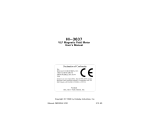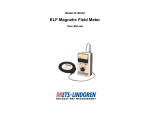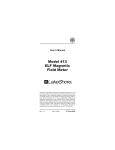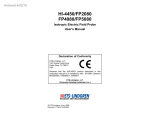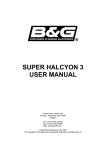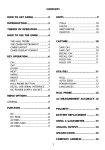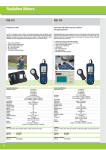Download HI-3627 ELF Magnetic Field Meter - ETS
Transcript
HI-3627 ELF Magnetic Field Meter User's Manual Copyright © 1992 Holaday Ind. Inc. Manual #600047 10/97 $8.50 Revision Record Manual #600047 HI-3627 ELF Meter Revision --A Description Preliminary Release Release Added CE Label Date 5/92 6/92 10/97 TABLE OF CONTENTS 1.0 Description . . . . . . . . . . . . . . . . . . . . . . . . 1 2.0 Specifications . . . . . . . . . . . . . . . . . . . . . . . 3 3.0 Operation . . . . . . . . . . . . . . . . . . . . . Introduction . . . . . . . . . . . . . . . . Quick Start . . . . . . . . . . . . . . . . Controls, Indicators and Connectors Recorder Output . . . . . . . . . . . . . Low Battery Indication . . . . . . . . . Recharging . . . . . . . . . . . . . . . . . 4.0 Making Measurements . . . . . . . . . . . . . . . . 11 5.0 Example Applications . . . . . . . . . . . . . . . . Mapping Power Lines . . . . . . . . . . . . . Locating and Mapping Underground Cables . . . . . . . . . . . . . . . . . . . . . . . VDTs . . . . . . . . . . . . . . . . . . . . . . . Residential Measurement Surveys . . . . Residential Ground Currents . . . . . . . . Ground Faults . . . . . . . . . . . . . . . . . . Pipe Inspections . . . . . . . . . . . . . . . . Site Surveys . . . . . . . . . . . . . . . . . . . .... .... .... ... .... .... .... 5 5 5 5 7 8 9 13 13 14 14 15 17 17 18 18 6.0 Maintenance . . . . . . . . . . . . . . . . . . . . . . 19 Battery Replacement . . . . . . . . . . . . . 19 7.0 Principle of Operation . . . . . . Probe . . . . . . . . . . . . . Input Signal Conditioning Filter Section . . . . . . . . RMS Circuitry . . . . . . . . Information Processing . . Power supply . . . . . . . . . . . . . . . . . . . . . . . . . . . . . . . . . . . . . . . . . . . . . . . . . . . . . . . . . . . . . . . . . . . . . . . . . . . . . . 21 21 21 21 23 23 23 8.0 Calibration . . . . . . . . . . . . . . . . . . . . . . . . 25 9.0 References . . . . . . . . . . . . . . . . . . . . . . . . 27 LIMITED WARRANTY HOLADAY INDUSTRIES, INC. WARRANTS EACH MODEL HI-3627 3AXIS ELF MAGNETIC FIELD METER BE FREE FROM DEFECTS IN MATERIAL AND WORKMANSHIP FOR A PERIOD OF ONE YEAR FROM DATE OF SHIPMENT TO THE PURCHASER. THIS WARRANTY EXTENDS TO THE ORIGINAL PURCHASER ONLY AND DOES NOT APPLY TO BATTERIES OR ANY PRODUCT OR PARTS SUBJECT TO MISUSE, NEGLECT, ACCIDENT, UNAUTHORIZED SERVICE OR ABNORMAL CONDITIONS OF OPERATION. IN THE EVENT OF INSTRUMENT FAILURE COVERED BY THIS WARRANTY, HOLADAY INDUSTRIES, INC. WILL, WITHOUT CHARGE, REPAIR AND RECALIBRATE THE INSTRUMENT IF RETURNED TO THEIR FACTORY WITHIN ONE YEAR OF THE ORIGINAL PURCHASE, PROVIDED THAT HOLADAY INDUSTRIES' EXAMINATION DISCLOSES TO ITS SATISFACTION THAT THE PRODUCT WAS DEFECTIVE. HOLADAY INDUSTRIES, INC. MAY, AT ITS OPTION, REPLACE THE PRODUCT IN LIEU OF REPAIR. IF THE DEFECT WAS CAUSED BY MISUSE, NEGLECT, ACCIDENT, UNAUTHORIZED SERVICE OR ABNORMAL CONDITIONS OF OPERATIONS, REPAIRS WILL BE BILLED AT A NOMINAL COST. IN SUCH CASE, AN ESTIMATE WILL BE PROVIDED BEFORE WORK IS STARTED IF REQUESTED BY THE PURCHASER. FOR WARRANTY SERVICE, CONTACT HOLADAY INDUSTRIES, INC. GIVING FULL DETAILS OF THE FAILURE AND THE SERIAL NUMBER OF THE INSTRUMENT. YOU WILL THEN BE GIVEN SERVICE INFORMATION OR SHIPPING INSTRUCTIONS. RETURN THE INSTRUMENT TO THE FACTORY TRANSPORTATION PREPAID. REPAIRS WILL BE MADE AT THE FACTORY AND THE INSTRUMENT RETURNED TO YOU TRANSPORTATION PAID. HOLADAY INDUSTRIES, INC. ASSUMES NO RESPONSIBILITY FOR LOSS OF, OR DAMAGE TO, PRODUCTS IN TRANSIT. WARNING SPECIAL CAUTION IS ADVISED WHEN WORKING IN ENVIRONMENTS WHERE CONTACT WITH HIGH VOLTAGE OR HIGH CURRENT CIRCUITS OR APPARATUS IS POSSIBLE. THIS IS PARTICULARLY TRUE WHEN ATTEMPTING TO OBTAIN ELECTRIC OR MAGNETIC FIELD STRENGTH MEASUREMENTS IN CONFINED QUARTERS, FOR EXAMPLE INSIDE CABINETS CONTAINING ELECTRICALLY OPERATED EQUIPMENT, ELECTRIC POWER SUBSTATIONS OR IN VERY CLOSE PROXIMITY TO THE CONDUCTORS OF ENERGIZED POWER LINES. ACCIDENTAL CONTACT WITH OBJECTS OR CIRCUITS OPERATED AT HIGH VOLTAGES OR HIGH CURRENTS CAN BE LETHAL! HOLADAY INDUSTRIES, INC. ASSUMES NO LIABILITY FOR DAMAGES OR PERSONAL INJURY WHICH MAY RESULT FROM ACCIDENTS ARISING OUT OF USE OF THIS EQUIPMENT. HI-3627 Manual 1.0 Page --1 Description The HI-3627 ELF Magnetic Field Meter is designed to measure the flux density of magnetic fields in the frequency range of 5 Hz to 2 kHz. This conforms with recent measurement guidelines issued in Sweden for extremely-low-frequency (ELF) magnetic fields produced by video display terminals (VDTs). The HI-3627 finds application in the measurement of magnetic fields associated with electric power lines, electrically operated appliances and VDTs. The HI-3627 is a three axis flux density meter designed to be responsive to either sinusoidal or complex magnetic field waveforms such as produced by the vertical deflection systems of VDTs. It computes the root-mean-square (RMS) value of magnetic flux density and directly displays it on an analog meter. The sensor consists of three multiturn loops connected to the instrumentation readout package via a 1.2 meter long cable. The microprocessor in the meter continually computes the magnitude of the field independent of the probe orientation. This allows quick assessment of the actual flux density value while conveniently holding the instrument for easy meter reading. This feature makes the HI-3627 especially useful for rapid, large area surveys of magnetic fields. The field sensor is electrically shielded making the response of the HI-3627 immune to most electric field effects. No interference is caused by ambient electric fields such as might be found beneath high voltage, overhead electric power lines or nearby radio or television stations. The HI-3627 has a wide dynamic measurement range. This provides for readings from 0.2 milligauss to 20 gauss. This large dynamic range makes the HI-3627 convenient for measurement of ambient residential magnetic fields as well as high level fields found near high current carrying conductors or electrical machinery. Page -- 2 HI-3627 Manual Page --3 HI-3627 Manual 2.0 Specifications Frequency Response: 30* Hz 2000 Hz < 30* Hz > 2000 Hz * - 3 dB - 3 dB Falling 80 dB/decade Falling 40 dB/decade (Note: The frequency response is switchable to 5 Hz) Figure 2-1 Sensor: External, three axis multi-turn loop, with inside diameter of 110 mm and outside diameter of 116 mm; loop area 0.010 m2. Cable length is 1.2 meters. Detector Response: True RMS field indication for accurate measurement of non-sinusoidal waveforms. Page -- 4 HI-3627 Manual Sensitivity: Full scale ranges of: 2 mG 20 mG 200 mG 2G 20 G Accuracy: ± 5 % at calibration frequency Power: One 9.6 volt NiCad battery Battery life: Approximately 30 Hrs. continuous operation (new battery with a full charge) Linearity: ± 2% Full Scale The instrument is calibrated using a one meter diameter pair of Helmholtz coils for establishing an accurately known magnetic field flux density. A precisely controlled and measured sinusoidal current is driven through the Helmholtz coils and, based on the dimensions of the coils, the magnetic field flux density between the coils is calculated. While the HI-3627 indicates magnetic flux density (B) in units of milligauss, the flux density in microtesla or magnetic field strength (H) in milliamperes per meter may be obtained via the following relations: 1 mG = .1 microtesla (:T) 1 mG = 80 milliamperes per meter (mA/m) HI-3627 Manual 3.0 Page --5 Operation Introduction This section defines and describes all controls, indicators and connectors. Refer to figure 3-1 for the location of the components. For experienced users or others who particularly dislike reading explanations of operation, the following is a quick start section that gets you up and running as quickly as possible. Quick Start To be brief, follow these steps: Step 1. Plug sensor into multi-pin connector at top end of the meter. Step 2. Turn the meter on by rotating the range selector switch one position clockwise. Note: the battery low LED will flash momentarily as the meter is turned on. Step 3. Verify that the over range LED and the battery LED are not illuminated. Step 4. Make measurements with the range selector switch set for the maximum reading without an over range indication. Controls, Indicators and Connectors The HI-3627 is housed in a rugged aluminum case with a detachable probe. The unit is shipped in a convenient carrying case with foam cutouts which accommodate the meter, probe and the optional accessories offered with the meter. Page -- 6 HI-3627 Manual Figure 3-1 The probe is detachable and consists of a sensing head containing three coils oriented to pick up the X, Y, and Z components of the field. The probe plugs into a multi-pin connector at the top end of the enclosure. There is also a 1/4 inch stereo phone jack on the end of the case. This is used to connect the battery charger and also provide a recorder output signal. See figure 3-1. Two switches control the operation of the HI-3627. The rotary selector switch turns on the instrument and selects one of five Page --7 HI-3627 Manual ranges for measurement. The scales are arranged so that when the meter is first turned on, the meter will be on it's least sensitive scale, ie. highest range. As the switch is rotated clockwise the sensitivity of the meter increases. Generally speaking, the readings will be most accurate when the meter movement has maximum deflection without an over range indication. A second toggle switch controls the desired low frequency cutoff. The user may select the lower frequency of the band pass for the instrument as either 30 Hz or 5 Hz. There are two LED indicators on the front panel. A "Low Battery" LED lights when the battery voltage is too low for accurate readings. After lighting, the batteries will provide about 10 minutes of useful operation. The "Over Range" LED illuminates when the field being measured exceeds the range selected on the HI-3627. Recorder Output The HI-3627 Magnetic Field Meter has a recorder output. The recorder output is a voltage signal (0-5 VDC) proportional to the needle deflection on the meter. This output can be used to drive a chart recorder, data logger, or other device to display the indicated field reading on the instrument. Figure 3-2 Page -- 8 HI-3627 Manual The connection for the recorder output is made through the same connector as the battery charger (refer to figure 3-2). This is a two circuit connector (jack) that mates with a standard ¼ inch stereo phone plug. The ring of the phone plug is reserved for battery charger input and the tip is connected to the recorder output. The shaft of the plug is the common ground. A diode in the battery charging circuit keeps the battery voltage from being applied to the recorder output when a plug is inserted into the jack. The recorder output comes directly from the circuit driving the meter movement. The maximum current available to the recorder output jack is 1 milliampere (5000 ohm minimum recorder output load). A lower impedance recorder output load will affect the accuracy of both the meter reading and the signal to the recorder output. The meter movement and the recorder output are driven by a PWM (pulse width modulator). This leads to a small amount of ripple on the recorder output, typically 50 mV at 40 Hz. Low Battery Indication The HI-3627 Magnetic Field Meter includes a "Low Battery" indicator. This is an LED mounted on the front panel (refer to figure 3-1). It is normal for the LED indicator to briefly blink when turning the switch to various ranges and when turning the instrument off. If the "Low Battery" indicator remains on during operation, the battery must be recharged. When the "Low Battery" LED lights, about 10 minutes of useful operation remains. This relatively short time is due to the output voltage of a NiCad battery remaining relatively flat until the battery is almost completely discharged, and then dropping very rapidly. HI-3627 Manual Page --9 Recharging Recharge the battery with either the standard trickle charger or the optional HI-3102 rapid charger. Recharging a fully discharged unit will take 15 hours with the standard trickle charger or one hour with the rapid charger. The standard charger provided with the HI-3627 is a trickle charger. It works by charging the battery with relatively low current. The charger can be left connected to the meter indefinitely without causing severe damage, although some memory effects may result. NiCad "memory" sometimes occurs when the battery is kept at full or nearly full charge without intervening discharge cycles. The effect is to reduce the apparent capacity of the battery and shows up as a short operating time before recharging is required. This effect can be minimized by occasionally operating the meter until the "Low Battery" LED indicates recharging is necessary. Charging time can only be reduced by increasing the current into the battery. If the higher current is not carefully monitored and stopped at the proper time, the battery will be permanently damaged. The optional HI-3102 battery charger has been developed in cooperation with a NiCad cell manufacturer to charge the NiCad battery at it's maximum rate. This charger is microcomputer controlled, and can safely recharge the NiCad battery pack fully in one hour. The HI-3102 charger uses a negative delta V algorithm to determine when the battery is fully charged allowing a battery of any discharge state to be brought to a full charge state without being overcharged. There are a number of chargers available for this type of NiCad battery pack. Some do a very good job of charging the battery, but others sacrifice battery life for charge time. The HI-3627 should be charged only with approved battery chargers. Page -- 10 HI-3627 Manual HI-3627 Manual 4.0 Page --11 Making Measurements To begin making field measurements, plug the probe into the meter. Turn the range switch to the right, increasing the instrument's sensitivity until an upscale reading on the meter is observed. The readings will be most accurate when maximum deflection is observed. When an over range indication does occur, the next larger range should be selected. It should be noted that the meter movement is protected against deflection past the top of scale. Therefore, the "Over Range" LED must be relied on to indicate an over range condition. It is not necessary to rotate the sensor to obtain a maximum indication on the meter. The value of flux density is obtained by taking three orthogonal measurements of the field. In this case, the sensor has three separate coils oriented in three mutually perpendicular directions around a fixed point. The resultant flux density is then found by calculating the root-sum-squared value from the individual RMS readings for each axis. For area surveys of ELF fields, the 30 Hz cutoff will be more useful. When the 5 Hz frequency cutoff is selected, the unit will be sensitive to movement of the sensor. This is due to the earth's constant magnetic field (approximately 500 mG). When the sensor is accelerated or rotated within this constant field, there will be an output from the sensor at a frequency corresponding to the movement. Consequently, during such movement, the meter will typically show significant upscale indications. The 5 Hz frequency cutoff setting is primarily useful for measurements at fixed coil positions such as near VDTs. Page -- 12 HI-3627 Manual Page --13 HI-3627 Manual 5.0 Example Applications of the HI-3627 Mapping Power Lines Magnetic fields near power lines can be easily measured with the HI-3627. An approach commonly used to characterize power line fields is to measure the flux density along a straight line which passes perpendicular to the power line. Generally, readings are first taken along the length of a span of the power line to identify the point at which the greatest flux density exists. Then at this point take the readings perpendicular to the power line. Take readings every five to ten feet. A magnetic field flux density profile can then be developed. This method is outlined by the Institute of Electrical and Electronics Engineers (IEEE) in the American National Standards Institute (ANSI) standard 644-1987 (1). Figure 5-1 Figure 5-1 is an example of a theoretical profile obtained for a 230 kilovolt (kV), single circuit line with 1000 amperes flowing in the conductors. For the particular case presented, the conductors are situated 50 feet above ground and are spaced Page -- 14 HI-3627 Manual 32 feet apart. The actual profile shape is dependent on the exact geometry of the power line, its height above ground and the current flowing in the line. The flux density peaks near a point beneath the conductors of the line. Locating and Mapping Underground Cables The HI-3627 with its omni-directional response is an effective and easy to use device for locating buried current carrying bodies. The procedure is quite simple. Hold the probe near the ground at a constant height and walk toward the highest field reading. A peak value usually means that you are standing above the current carrying body. A similar approach may be used for measuring the flux density produced by buried lines. In this case, the area must be explored by walking about with the meter until the region of maximum flux density is found. Then, as in mapping power lines, you would make straight line passes perpendicular to the buried cable recording readings at fixed intervals. VDTs VDTs produce ELF magnetic fields which come about from the circuitry within the VDT which deflects the electron beam vertically in the cathode-ray-tube (CRT). ELF fields may also be generated by the VDT power supply. The magnetic fields are used to deflect the beam and have a saw-tooth waveform with frequencies ranging between approximately 45 Hz and 75 Hz, depending on the particular design of the VDT. The HI-3627 is designed to properly detect these magnetic fields because of its RMS detector and wide bandwidth. Two different methods for VDT magnetic field measurements have been commonly used. The first is that of characterizing the field at a fixed distance from the screen of the VDT. Conventionally, distances of 30 cm and 50 cm have been used for such measurements. Normally, the measurements are taken from the front surface of the screen. Additional measurements HI-3627 Manual Page --15 may be taken relative to the sides, the top and the back of the VDT to explore the distribution of the fields about the VDT. The second method involves a measurement at the position of the VDT operator to assess the flux density to which the operator is actually exposed while sitting at the VDT. Because different individuals will sit at different locations and have different postures, the operator exposure measurement may be more a function of the operator than of the specific VDT. A reasonable approach for the operator exposure measurement is to position the sensor at a point corresponding to where the center of the body would be located during operation of the VDT. It is important to note that the magnetic fields decrease very rapidly with increasing distance from the screen. Because of this characteristic, it is important to insure that the position of the sensor is precisely known. Attempts to repeat the measurement results will be hampered by unnecessary variability if the sensor is not replaced at the same exact position. Spacing measurements should be made from the VDT surface to the center of the sensor. The Model HI-3627 contains circuitry to extend the lower frequency response down to 5 Hz in accordance with recommendations used for VDT measurements according to the guidelines issued in Sweden for extremely-low-frequency (ELF) magnetic fields produced by video display terminals (VDTs). The user is referred to the Swedish specifications for measurement (2) for application details. Residential Measurement Surveys Magnetic fields found in home environments are highly variable, depending on location within the home. This variability is strongly related to the distribution of the wiring in the home, the location of electrical appliances and, sometimes, the location of plumbing lines or other metallic structures within the ground which may form low resistance paths for electrical ground Page -- 16 HI-3627 Manual return currents. Establishing what the ambient magnetic field environment is in a home usually requires numerous measurements throughout the home, with at least one measurement within each room. Normal practice would include at least one field measurement taken near the center of each room. A more thorough approach would include five measurements in each room, one at the center and one near each corner of the room. A reasonable technique is to position the sensor at a point approximately one meter from each room corner for the flux density measurement. This avoids, to an extent, placing the sensor immediately next to wiring which may be hidden within the walls of the room and which may yield unrealistically high values of flux density compared to what most individuals within the room might be exposed. A possible protocol for making the measurements is outlined in the California Department of Health Services paper on suggested protocol for measuring 60 Hz magnetic fields in residences (3). Surveys of the areas near electrical appliances will usually reveal higher values of flux density due to the currents flowing within motors or heating elements. This may influence the location of beds, and other locations of extended occupancy. In characterizing the magnetic fields near obvious sources, such as appliances, it is often helpful to measure and record the flux density value at intervals of a few inches (or centimeters) beginning near the surface of the device. These data will help provide a perspective on the spatial extent of the elevated field levels and the significance of the levels relative to other values determined elsewhere within the home. Field measurements should take into account the likelihood that individuals may have access to areas where measurements are contemplated. Because 60 Hz magnetic fields produced by the use of electricity within the home are dependent on the magnitude of current flowing within wires or the operation of appliances, flux densities will be seen to vary with time, being greater when more electrical power is being used. For example, when heating or air conditioning systems turn on or the compressor within a refrigerator cycles on, the flux density will increase. HI-3627 Manual Page --17 Measurements must take this condition into account. It is recommended when taking measurements in a room, the meter be watched for a period of time to observe for fluctuations in the indicated value of flux density. After some experience, it may be possible to relate the observed fluctuations to various uses of electricity within the home. Residential Ground Currents A phenomenon, which recently received attention in regard to residential magnetic fields, is the flow of earth currents via plumbing lines or telephone cables buried beneath the home. In some cases, it has been noted that 60 Hz magnetic fields exist within a home, even when the home is not using any electrical power (the circuit breakers have all been turned off at the main electrical service box of the home). This observation has, in some cases, been related to the flow of currents beneath the home on pipes or cables. It is not unusual for currents related to other neighbors' use of electricity to flow back to the electrical supply via low resistance paths. These are formed by metal plumbing pipes or wires used for telephones as opposed to the electrical system neutral wire. In such cases, it is possible to measure magnetic flux densities within the home even though the power to the home has been shut off. Ground Faults As mentioned earlier, current can exist in pipes and heating ducts or anything metal in the house. This gives rise to an interesting application for the HI-3627; detecting leakage currents from appliances. For example it was noted that the fields around a water pipe leading from a dishwasher changed dramatically when the dishwasher was run. It was later found that the dishwasher was defective and allowed excessive ground currents to flow. The same principles apply to industrial and power distribution situations. Page -- 18 HI-3627 Manual Pipe Inspections It was noted that the buried pipes leading to fire hydrants tended to concentrate the currents flowing in the ground from power distribution leakages. The field from this current could be detected and measured. It was also noted that the field would vary uniformly as the operator walked along the pipe. The field would, however, exhibit significant variations at points on the pipe where there was a break or a large amount of corrosion. In this way a single operator with very little equipment could inspect a large section of pipe for possible failures in a very short period of time. This, of course, is a singular example that only worked because of very unusual circumstances, but it does show the versatility of this easy to use field meter. Site Surveys Site surveys are another useful application. This example was in an office with several CRT terminals. It was found that several times a day the images on the screens would start to move in a waving fashion. It was discovered by surveying the room that a power distribution cable for an industrial user was routed near the room. The cable was moved and the problem went away. Page --19 HI-3627 Manual 6.0 Maintenance Battery Replacement The battery pack used in the HI-3627 Magnetic Field meter is a commonly available NiCad battery pack (Holaday part # 491044, 9.6 Volt, 600 mA-H, or equivalent). In the event of battery failure, a new battery can be obtained from Holaday Industries or from a local source. The battery pack is replaced by removing the back cover of the meter, unplugging the battery, and removing the battery retainer. Replace the battery pack by reversing these steps. The back cover is fastened by six screws that can be found around the lip if the front panel. The battery is retained by two more screws and a metal strap that holds the battery in place (a #1 Phillips screw driver will work well for these operations). CAUTION Never short the output of a NiCad battery (even a discharged battery). The resultant currents will be large. This will cause the lead wires to become extremely hot which can cause severe burns and/or fire. Page -- 20 HI-3627 Manual HI-3627 Manual 7.0 Page --21 Principle of Operation The circuitry of the HI-3627 can be divided into six sections; the probe, input signal conditioning, filter section, RMS calculation, information processing and power supply. Each of these is discussed in the follow sections (see Figure 7-1). Probe The probe consists of three concentric shielded coils aligned with their axes perpendicular to one another. The electrostatic shield of each coil is isolated from that of the other. The shields are connected together at a single point at the base of the sphere defined by the coils. The signals from each coil are brought to the meter through a shielded twisted pair cable with its shield connected to the coil shield common point. Input Signal Conditioning The output voltage of a coil varies with the frequency of the applied magnetic field. A single pole low pass filter is added to the output of each coil to flatten the frequency response and provide impedance matching. The input signals are then passed through a programmable gain amplifier stage that provides the necessary amplification for the individual ranges. The signals then pass to the filter section. Filter Section Each channel is filtered separately. The first stage is a two pole Butterworth low pass filter at 2000 Hz. A Butterworth filter attenuates the signal by 3 dB at the cutoff frequency with attenuation in the stop band and no ripple in the pass band. The output of the low pass filter is fed into two 4 pole high pass filters. The cutoff frequencies on these filters are 5 Hz and 30 Hz corresponding to the low frequency cutoff selections. Page -- 22 HI-3627 Manual HI-3627 Manual Page --23 The front panel switch controls an analog multiplexer which selects the proper filter output. RMS Circuitry The signal from each filter is fed into one of three true RMS converter integrated circuits, one for each channel. The time response of the RMS converter is selected to give acceptable step input response time while yielding minimal RMS conversion errors at 5 Hz. This time constant is around 500 msec. This is the predominant time constant of the meter. Information Processing The outputs of the three true RMS converters are combined through vector addition to calculate the resultant field magnitude. This computation is computed by a processor and an A/D converter. The meter is driven by outputs configured as a PWM (Pulse Width Modulator). The processor performs an A/D conversion on the signal from each axis by programming an analog multiplexer into a 12 bit A/D converter. The digital values are then squared, summed and the square root of the sum is calculated. This result is used to set the duty cycle of the PWM output which drives the meter movement. The output frequency of the PWM is about 30 Hz. This frequency is too high to show on the analog meter, but can be detected as about 50 mV of ripple on the recorder output. Power supply Power is supplied to the HI-3627 by a NiCad battery. The NiCad battery chosen for this application is a common type. The current consumption of the instrument is relatively low with the operating life being greater than 30 hours of continuous operation. During typical daily operation, with intermittent use, the time between recharges will be greater. The individual voltages supplied to the circuitry are derived from the battery voltage directly, supplied through series pass regulators and from a switched capacitor voltage invertor. Page -- 24 HI-3627 Manual HI-3627 Manual 8.0 Page --25 Calibration The HI-3627 is calibrated using a one meter diameter Helmholtz coil. Each axis is individually calibrated. Calibration is performed at 60 Hz at levels of 200 mG and 2 G. All calibrations are traceable to NIST. The frequency response of each axis is checked in all meters. The recommended recalibration interval is one year. Holaday Industries offers complete recalibration services which comply with MIL-STD 45662A. Page -- 26 HI-3627 Manual HI-3627 Manual 9.0 Page --27 References (1) IEEE Standard Procedures for Measurement of Power Frequency Electric and Magnetic Fields from AC Power Lines. ANSI/IEEE standard 644-1987. Published by The Institute of Electrical and Electronics Engineers, Inc., 345 East 47th Street, New York, NY 10017. Approved November 17, 1986. (2) Swedish National Board for Measurement and Testing, Test Methods for Visual Display Units- Visual Ergonomics and Emission Characteristics. MPR 1990:8, 1990-12-01, National Board for Measurement and Testing, Box 878, S-501 15 Bors, Sweden. (3) Electric and Magnetic Field Measurements and Possible Effects on Human Health from Appliances, Power Lines, and Other Common Sources. Special Epidemiological Studies Program, California Department of Health Services, 2151 Berkeley Way, Room 704, Berkeley, Ca. 94704 (415)540-2669 Page -- 28 HI-3627 Manual --NOTES--





































